Meltdown & Spectre: Analyzing Performance Impacts on Intel's NUC7i7BNH
by Ganesh T S on March 23, 2018 4:15 PM EST- Posted in
- Systems
- Spectre
- Benchmarks
- Meltdown
BAPCo and Futuremark Benchmarks
BAPCo's SYSmark 2014 SE is an application-based benchmark that uses real-world applications to replay usage patterns of business users in the areas of office productivity, media creation and data/financial analysis. In addition, it also addresses the responsiveness aspect which deals with user experience as related to application and file launches, multi-tasking etc. Scores are meant to be compared against a reference desktop (the SYSmark 2014 SE calibration system in the graphs below). While the SYSmark 2014 benchmark used a Haswell-based desktop configuration, the SYSmark 2014 SE makes the move to a Lenovo ThinkCenter M800 (Intel Core i3-6100, 4GB RAM and a 256GB SATA SSD). The calibration system scores 1000 in each of the scenarios. A score of, say, 2000, would imply that the system under test is twice as fast as the reference system.
We see that the patching does have an impact on the performance. It ranges from around 5% for the Office Productivity scenario to around 10% for the Responsiveness metric.

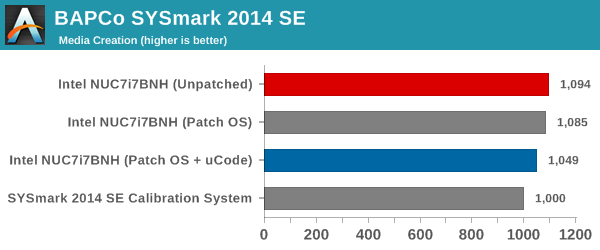

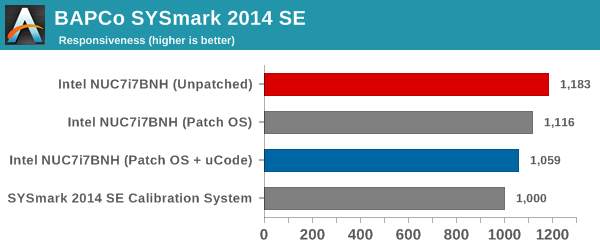
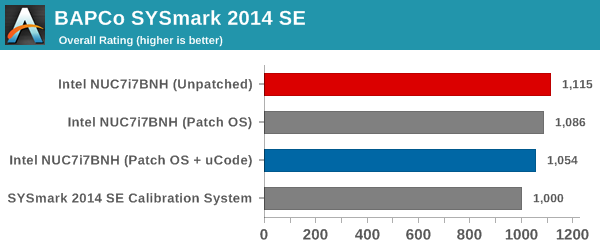
SYSmark 2014 SE also adds energy measurement to the mix. We see that the patched system, despite being slower, consumes lower energy for the completion of the tasks.
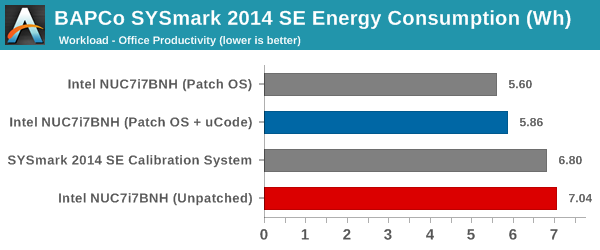
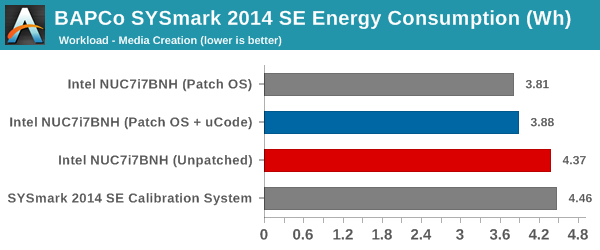
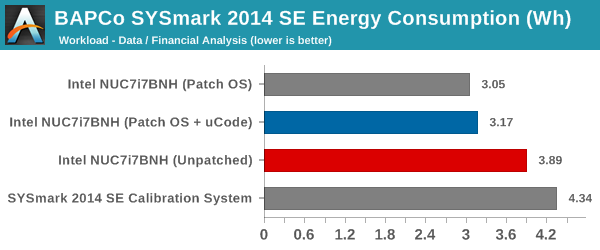
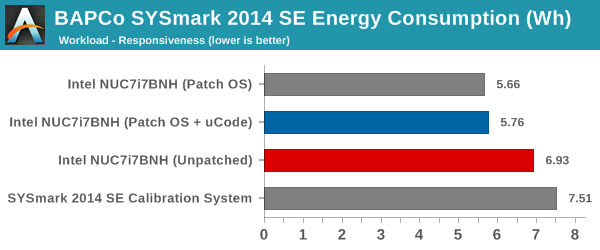

Futuremark PCMark 10
UL's PCMark 10 evaluates computing systems for various usage scenarios (generic / essential tasks such as web browsing and starting up applications, productivity tasks such as editing spreadsheets and documents, gaming, and digital content creation). We benchmarked the configurations with the PCMark 10 Extended profile and recorded the scores for various scenarios. These scores are heavily influenced by the CPU and GPU in the system, though the RAM and storage device also play a part. The power plan was set to Balanced for all the PCs while processing the PCMark 10 benchmark.
Similar to SYSmark 2014 SE, we see performance impacts in all the PCMark 10 scenarios also. For example, the Essentials workload score for the fully patched system is around 6.5% lower than the unpatched system. The gaming workload doesn't seem to be affected much by the patching, though. The overall score is around 2.3% lower.





Futuremark PCMark 8
We continue to present PCMark 8 benchmark results (as those have more comparison points) while our PCMark 10 scores database for systems grows in size. PCMark 8 provides various usage scenarios (home, creative and work) and offers ways to benchmark both baseline (CPU-only) as well as OpenCL accelerated (CPU + GPU) performance. We benchmarked select PCs for the OpenCL accelerated performance in all three usage scenarios. Since these scores are heavily influenced by the CPU in the system, it is not surprising to see a performance impact. The patched configuration, on average, scores around 2% lower than the unpatched one.



Miscellaneous Futuremark Benchmarks

PCMark 7's PCMark Suite shows a 4% performance loss.

3DMark 11's entry level score and 3DMark 2013's Cloud Gate score actually end up better after the patch, but, 3DMark 2013's Ice Storm score shows a performance loss of more than 13%.


Futuremark PCMark 8 Storage Bench
PCMark 8 has a storage bench where certain common workloads such as loading games and document processing are replayed on the target drive. Results are presented in two forms, one being a benchmark number and the other, a bandwidth figure. We ran the PCMark 8 storage bench on the ADATA NVMe SSD in all the configurations.


While the absolute score is just around 1.3% lower for the patched configuration, the storage bandwidth is around 29% worse. This significant performance loss is partly due to the NVMe drive performance now being CPU bound. It is highly likely that SATA drives will not experience such a drastic performance loss due to the patching.










83 Comments
View All Comments
Klimax - Sunday, March 25, 2018 - link
Just well chosen set of likely badly written projects to get wanted conclusion...ZolaIII - Sunday, March 25, 2018 - link
What isn't correct there? Why don't you write better one's as source is there? The general tests as SQL, web serving or Github init create & compile times are among many real use & not synthetic benchmarks. You may not find those crucial on standard desktop, on workstation and small server they are & OS choose dictated upon them & system purpose on large server space you won't find anything called Windows there even M$ embraced Linux there (Azure platform).Now try to explain what is your so called "wanted conclusion"? While Linux makes his small talks how he still isn't satisfied with fixes person mostly struck with the regressions & solely most responsible one for the getting Linux to performance leading platform & on much more architectures than any other OS ever supported is Peter Zijlstra.
Now buzz off!
ZolaIII - Sunday, March 25, 2018 - link
Linus*nismotigerwvu - Friday, March 23, 2018 - link
Wow, it looks like this puts Intel behind AMD on IPC for the first time since 2006, at least until new SKUs come to market.mkaibear - Saturday, March 24, 2018 - link
Nah, Zen was about 7% behind on IPC on average, this gets AMD closer but not quite there yet.Means picking a system based on use case has got more interesting though.
Klimax - Sunday, March 25, 2018 - link
Since AMD doesn't have patch for Specters ready, such conclusion is not warranted yet.phoenix_rizzen - Friday, March 23, 2018 - link
Are the OS patch levels listed correct?.125 is unpatched.
.309 is Meltdown-only patched.
.214 is both patched.
Should that last one be .314?
ganeshts - Saturday, March 24, 2018 - link
Initially, I wanted to present only the unpatched and fully patched results.Unfortunately, I have a number of PCs pending review that don't seem to be receiving BIOS updates anytime soon (despite Intel having released the final microcode for its patching). Hence, I had to add the OS-patch only scenario at the last minute after rolling back the BIOS.
So, the order of testing was :
1. Unpatched
2. Both Patched
3. Only OS patched
Drazick - Saturday, March 24, 2018 - link
How did you make your system unpatched?Ryan Smith - Saturday, March 24, 2018 - link
There are registry settings available in Windows to turn off the OS patches. Steve Gibson's InSpectre can twiddle the necessary bits rather easily: https://www.grc.com/inspectre.htm